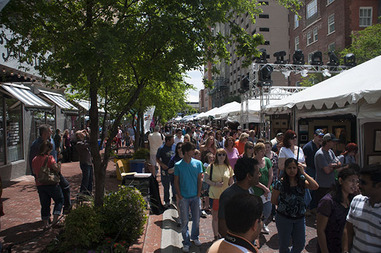When I’m at a show, it’s inevitable that people visiting my booth will exclaim “they look like photographs”, referring to my drawings. It’s not rare that sometimes a person will argue with me, either facetiously or sometimes seriously, that they must be photos. I take it as a compliment, of course, but my work is much more than that.
A word that’s often thrown casually about is “photorealism”. While there are usually at least a few elements within the whole piece that might fall into that category, my work really isn’t entirely photorealistic. It’s realism, for sure. I strive to create works that take you, through much detail, right into the subject. However, there’re usually far more elements of the compositions that fall firmly outside such a designation. Much of the work is an impression of highly detailed realism without actually going there. It’s a trick of the eye and mind. By including just enough detail in the most important places, I’ve tricked your mind into believing that the entire work has photorealistic detail.
In doing this, I’m not trying to deceive you. I am giving my work a depth of interest that it would not otherwise have if every single little detail were recreated on every square inch of the drawing. THAT would be mere reproduction of reality and, in my humble opinion, a bit pointless when a camera and a bit of Photoshop™ work would be a much more efficient way to accomplish it. And while it certainly makes for a great display of technical ability, it doesn’t necessarily make for a piece of art that is interesting beyond the initial “wow” of technical prowess.
My drawings pull you in with that initial impact, but then they let you explore the forms – the light and shadow – as well as the soul of the subject that goes past that initial smack in the face. You, as the viewer, actually complete the work in your own mind, filling in the details I’ve left out. I’m involving you much deeper with my work by asking you to do part of the work. I allow you to venture into the drawing rather than tell you everything there is to know at the outset. The effect is that each person has their own reaction and each “finishes” the drawing in their own way by pulling from and applying their own life experiences.
My approach of having some extreme detail alongside more impressionistic areas, allows my work to have an impact both up close and from a distance. So often I hear people talk about the idea that while a drawing is compelling from across a room, it looks just as interesting, in a different way, up close. At close range, you see the details – the technical aspects of the work. From a distance, it is the compositional impact – the emotion of the work – that draws the attention.
I’m often told my drawings are “quiet”. Last September at the Saint Louis Art Fair, I was fortunate enough to win one of the Juror's Choice awards. There are three, given by each juror to the body of work they found to be their personal favorite. Jennifer Perlow, a gallerist, curator and the juror who honored me, talked about my work in presenting the award and why she selected it. For her, it was about the quiet nature of my work – "technically proficient", she observed, yet far deeper and, quite simply, "quiet". She got it. She got it to the core! My subjects are many, from big, impressive African animals, to trees and to skies that may be calm and clear or roiling with storms. Still, in each piece there is a quiet feel. A calmness. A place of escape either to a memory or even a fantasy.
When I think of “the quiet”, it is the idea that regardless of the subject, the commonality of all my work is the overall quiet I hope a viewer will feel. The regal lion staring off into the distance, lost in his thoughts; the forest of aspen in the snow waiting for warmer temperatures and the thaw of Springtime; or even the boiling thunderheads amassing in the sky above, all have a quietness, despite what might at first seem like action, that draws you in. A peacefulness that allows you to pause and reflect. You might have a recollection of a place or time or even a story you’ve read. I want you to connect to the soul of my work. Get yourself lost in it. Forget about the technical aspects. Enjoy the work for all that it is. The whole, not its parts. Let yourself go. Be calmed. It’s about “the quiet”.
A word that’s often thrown casually about is “photorealism”. While there are usually at least a few elements within the whole piece that might fall into that category, my work really isn’t entirely photorealistic. It’s realism, for sure. I strive to create works that take you, through much detail, right into the subject. However, there’re usually far more elements of the compositions that fall firmly outside such a designation. Much of the work is an impression of highly detailed realism without actually going there. It’s a trick of the eye and mind. By including just enough detail in the most important places, I’ve tricked your mind into believing that the entire work has photorealistic detail.
In doing this, I’m not trying to deceive you. I am giving my work a depth of interest that it would not otherwise have if every single little detail were recreated on every square inch of the drawing. THAT would be mere reproduction of reality and, in my humble opinion, a bit pointless when a camera and a bit of Photoshop™ work would be a much more efficient way to accomplish it. And while it certainly makes for a great display of technical ability, it doesn’t necessarily make for a piece of art that is interesting beyond the initial “wow” of technical prowess.
My drawings pull you in with that initial impact, but then they let you explore the forms – the light and shadow – as well as the soul of the subject that goes past that initial smack in the face. You, as the viewer, actually complete the work in your own mind, filling in the details I’ve left out. I’m involving you much deeper with my work by asking you to do part of the work. I allow you to venture into the drawing rather than tell you everything there is to know at the outset. The effect is that each person has their own reaction and each “finishes” the drawing in their own way by pulling from and applying their own life experiences.
My approach of having some extreme detail alongside more impressionistic areas, allows my work to have an impact both up close and from a distance. So often I hear people talk about the idea that while a drawing is compelling from across a room, it looks just as interesting, in a different way, up close. At close range, you see the details – the technical aspects of the work. From a distance, it is the compositional impact – the emotion of the work – that draws the attention.
I’m often told my drawings are “quiet”. Last September at the Saint Louis Art Fair, I was fortunate enough to win one of the Juror's Choice awards. There are three, given by each juror to the body of work they found to be their personal favorite. Jennifer Perlow, a gallerist, curator and the juror who honored me, talked about my work in presenting the award and why she selected it. For her, it was about the quiet nature of my work – "technically proficient", she observed, yet far deeper and, quite simply, "quiet". She got it. She got it to the core! My subjects are many, from big, impressive African animals, to trees and to skies that may be calm and clear or roiling with storms. Still, in each piece there is a quiet feel. A calmness. A place of escape either to a memory or even a fantasy.
When I think of “the quiet”, it is the idea that regardless of the subject, the commonality of all my work is the overall quiet I hope a viewer will feel. The regal lion staring off into the distance, lost in his thoughts; the forest of aspen in the snow waiting for warmer temperatures and the thaw of Springtime; or even the boiling thunderheads amassing in the sky above, all have a quietness, despite what might at first seem like action, that draws you in. A peacefulness that allows you to pause and reflect. You might have a recollection of a place or time or even a story you’ve read. I want you to connect to the soul of my work. Get yourself lost in it. Forget about the technical aspects. Enjoy the work for all that it is. The whole, not its parts. Let yourself go. Be calmed. It’s about “the quiet”.


